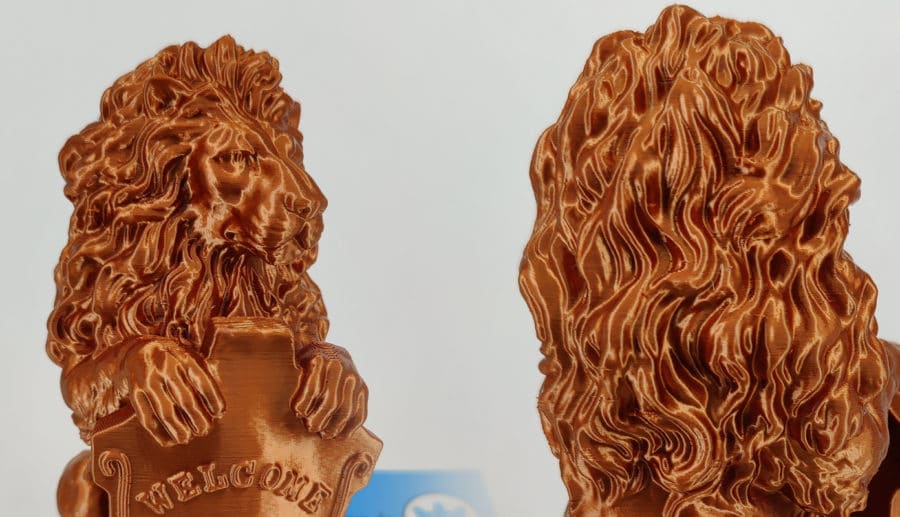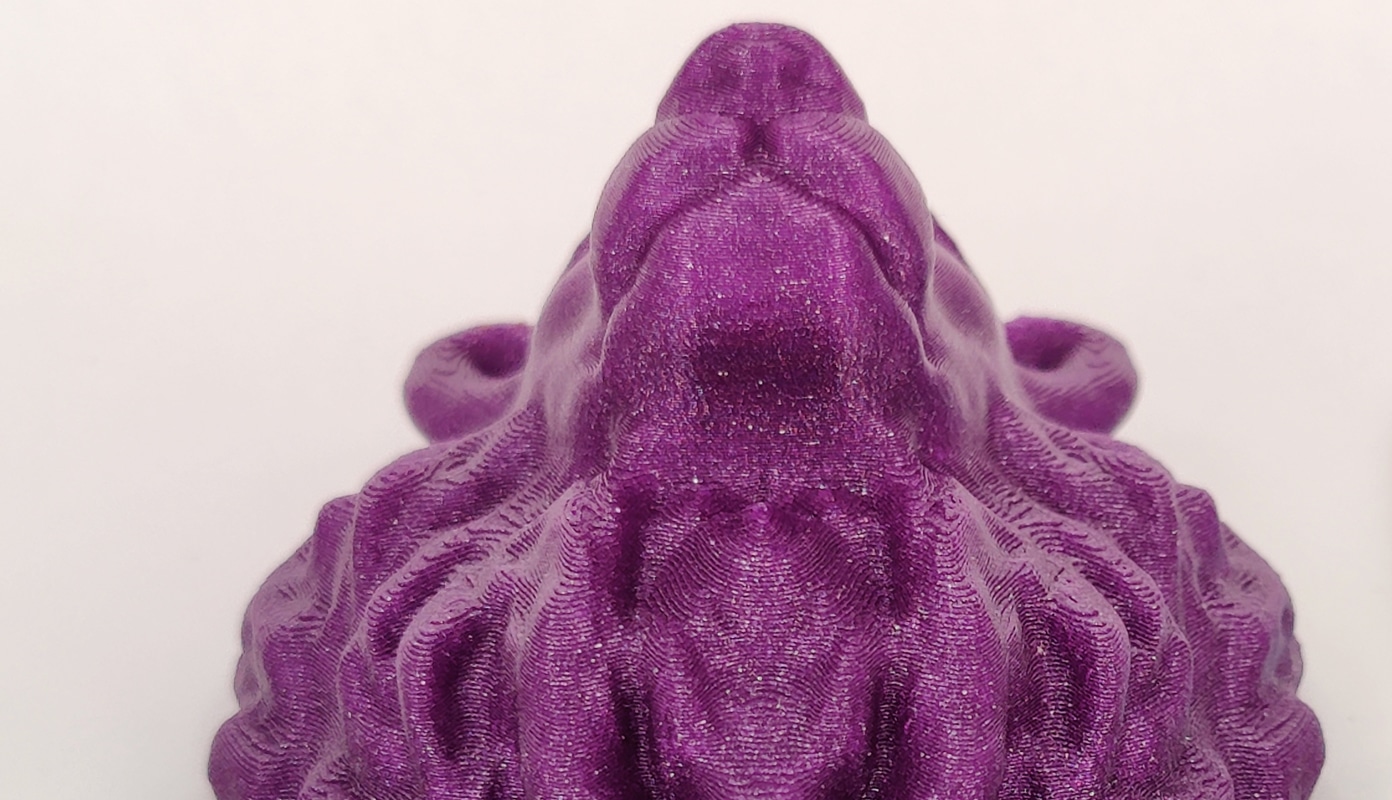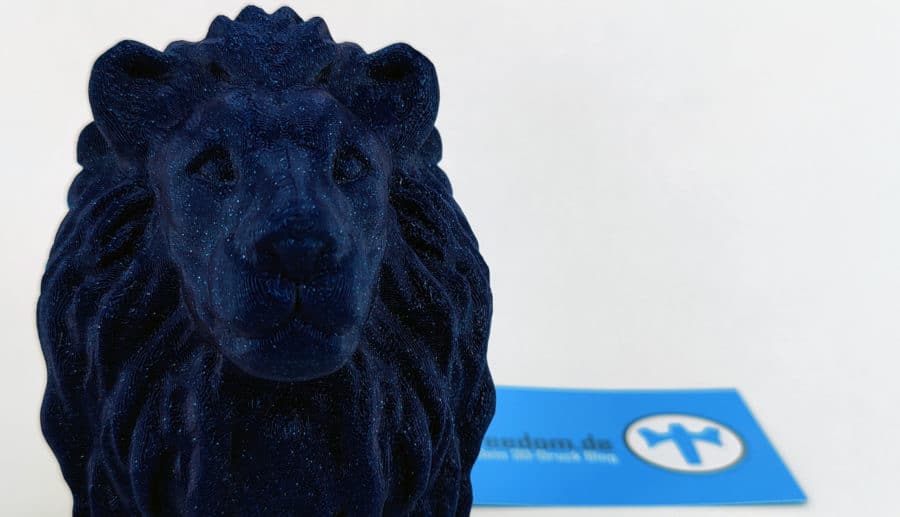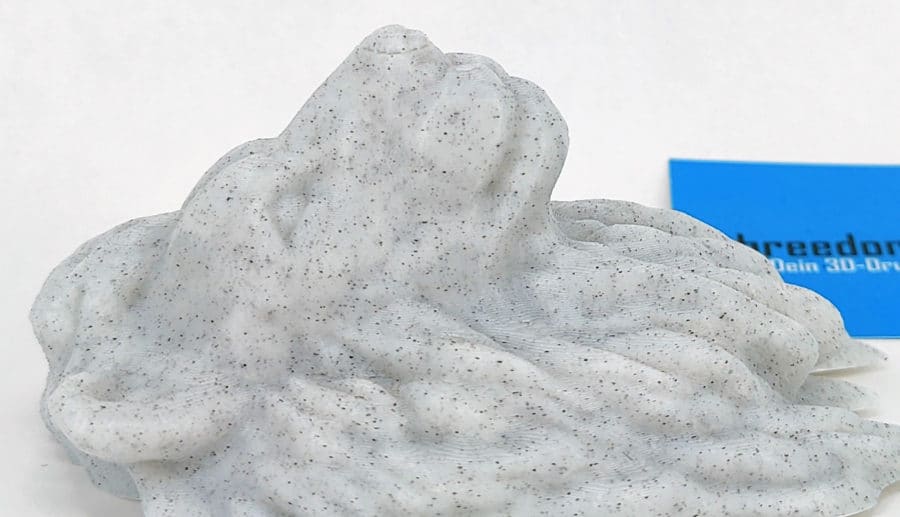3D Printer Filament – Everything you need to know!
In this article you will learn everything about 3D printer filament. In doing so, I'll start with the basics. Then I'll introduce you to the production process and move on to the different types of filament. Furthermore, you will learn what to look for when buying and what is the difference between filament for 3D printers and 3D pens.
What is filament?
In order to operate a 3D printer and produce various objects with it, it needs appropriate material. Especially for 3D printers for home use, these are usually special plastics that have different properties depending on their composition. These plastics are called filament.
Incidentally, the term filament is derived from the Latin word filamentum, which stands for threadwork. This alone shows how the material is used – as a thin thread running continuously in the same thickness.
The 3D printer filament itself is usually offered in two different thicknesses. By default, most users use 1.75 mm thick filament, but others have a thickness of 3 mm or 2.85 mm. When choosing the nozzle (Nozzle) you have to consider the filament thickness to get a consistent print result.
3D Printer Filament Types-What materials are there and what can they do?
| Name | Anwendung | Festigkeit | Flexibilität | Haltbarkeit | Druckbarkeit | Drucktemp. [°C] | Heizbett [°C] |
|---|---|---|---|---|---|---|---|
| Wood | Dekoartikel | ⭐⭐ | ⭐⭐ | ⭐⭐ | ⭐⭐ | 195 - 220 | keins / 50 - 60 |
| PLA Metal | Schmuck / Deko | ⭐⭐ | ⭐ | ⭐⭐⭐ | ⭐⭐⭐ | 195 - 220 | keins / 50 - 60 |
| PLA Glow-In-The-Dark | Spaß / Markierungen für dunkle Stellen | ⭐⭐ | ⭐⭐ | ⭐⭐ | ⭐ | 215 | keins / 50 - 60 |
| PLA | Nahezu alle | ⭐⭐ | ⭐ | ⭐⭐ | ⭐ | 180 - 220 | keins / 50 - 60 |
| PETG | Nahezu alle | ⭐⭐ | ⭐⭐⭐ | ⭐⭐⭐ | ⭐⭐ | 220 - 235 | keins / 70 - 80 |
| Nylon | Nahezu alle | ⭐⭐⭐ | ⭐⭐⭐ | ⭐⭐⭐ | ⭐⭐ | 220 - 260 | 50 - 100 |
| nGen | Nahezu alle | ⭐⭐ | ⭐⭐⭐ | ⭐⭐⭐ | ⭐⭐ | 210 - 240 | 75 - 85 |
| HIPS | Als Support Material nutzbar | ⭐ | ⭐⭐ | ⭐⭐⭐ | ⭐⭐ | 210 - 250 | 50 - 100 |
| Leitfähig | Elektronik | ⭐⭐ | ⭐⭐ | ⭐ | ⭐ | 200 - 230 | keins / 60-70 |
| Reinigend | Düsen Reinigung | - | - | - | ⭐ | 150 - 240 | Nur Extrusion |
| ASA | Außeneinsatz möglich | ⭐⭐ | ⭐ | ⭐⭐⭐ | ⭐⭐ | 230 - 260 | 100 - 120 |
| ABS | Funktionsbauteile | ⭐⭐ | ⭐⭐ | ⭐⭐⭐ | ⭐⭐ | 220 - 250 | 85 - 110 |
⬆️ : High | ➡️ : Medium | ⬇️ : Low | ❌ : No specification found
Sources: Empirical values, averaged manufacturer data, Wikipedia.
Filament with special properties and special additives
Above “standard” filament is now available everywhere and everyone produces or sells them. To differentiate themselves from the competition, 3D printer manufacturers are moving to produce increasingly sophisticated materials and make them palatable to customers.
In the following, I will list all variants known to me and also give some tips on manufacturers and dealers.
- Luminous filament
- Conductive filament
- Wood filament (not to be confused with wood-like material)
- Carbon Filament
- Cleaning filament
- Filament in RAL colors
- Filament with metal additives
- Glitter Filament
- Marble Filament
- Metallic look filament
Luminous filament
Luminous filament glows, as the name suggests. Sometimes also blue 😉
In many cases, the starting material is PLA, which makes it relatively easy to print. From time to time, however, PETG and ABS are also available in the Glow-In-The-Dark version. If you haven't printed much ABS before or haven't had any success, you're also better off switching to “easier to print” types for luminescent filament.
Keep in mind, however, that luminescent filament is abrasive due to the luminescent particles and thus wears out the nozzle of your 3D printer faster than normal filament.
| Marke | Name | Details |
|---|---|---|
| Amolen | Glow Blau | [su_button url="https://amzn.to/2Iq5X9a" target="blank" style="flat" background="rgb(71, 164, 71)" color="#ffffff" size="6" wide="yes" center="yes" radius="5" icon_color="#37aecf" text_shadow="0px 0px 0px #000000"]Einkaufen*[/su_button] |
| Amolen | Glow Rot | [su_button url="https://amzn.to/36oribs" target="blank" style="flat" background="rgb(71, 164, 71)" color="#ffffff" size="6" wide="yes" center="yes" radius="5" icon_color="#37aecf" text_shadow="0px 0px 0px #000000"]Einkaufen*[/su_button] |
| GIANTARM | Luminous Blau PLA | [su_button url="https://amzn.to/3eJ7nIj" target="blank" style="flat" background="rgb(71, 164, 71)" color="#ffffff" size="6" wide="yes" center="yes" radius="5" icon_color="#37aecf" text_shadow="0px 0px 0px #000000"]Einkaufen*[/su_button] |
| Stronghero3D | Glow Grün Blau Verlauf | [su_button url="https://amzn.to/38rgBHL" target="blank" style="flat" background="rgb(71, 164, 71)" color="#ffffff" size="6" wide="yes" center="yes" radius="5" icon_color="#37aecf" text_shadow="0px 0px 0px #000000"]Einkaufen*[/su_button] |
More about this:
Conductive filament
Conductive 3D filament belongs to the special filaments that truly have a special property. Of course, the conductivity, for example, is not the same as a copper cable.
However, you can use it to print a house, for example, with a dual-extruder printer, and inside the house you can print the lines for the LED lighting. Currently you can get conductive filament from yourDroid*, AMOLEN* or 3dk.berlin.
Wood Filament
material with the addition of small wood chips are about the first special filaments, which already existed in 2014/2015. As a rule, the material is easy to print and – what is very nice – sanded like wood. Depending on the proportion of wood, this effect is sometimes better and sometimes worse to achieve.
In the meantime, there are many different types of wood for your 3D printer. For example, you can also print bamboo.
More about this:
Carbon Filament
When carbon is mentioned, many people listen. The material has certainly fascinated not least since the racing games or films in which tuning parts made of carbon are always highly praised.
Now you can also print yourself some stable objects. However, you need to keep two things in mind:
- Carbon fiber can work best when this fiber is not interrupted. However, in filament you will find small pieces and not a single fiber. There are special 3D printers that can print fibers, but normal FDM printers cannot. Therefore, please do not expect the same effect that a component made of carbon fiber would actually have.
- The material is abrasive. This means that with each pressure your nozzle will be more worn than with normal filament. It is therefore recommended that you buy some spare nozzles before you print masses of this material. Otherwise, you'll wonder later why your printer isn't working as well as it used to.
* Stand: 2024-04-21 / Bilder: Amazon API
Cleaning filament
At regular intervals, the nozzle of the extruder installed in the 3D printer must be cleaned. This is possible, for example, with special cleaning filament. The nozzle temperature can be selected here between 150 and 240 degrees Celsius. Since only one extrusion is made, any heating bed that may be present does not need to be heated.
* Stand: 2024-04-21 / Bilder: Amazon API
Filament in RAL colors
Filaments are available not only in standard colors, but also in numerous RAL colors. The selection of PLA filaments is very extensive. By the way, the RAL code number also makes it possible to order 3D printing filaments developed by oneself in terms of color composition from various manufacturers, which are then produced in the desired quantity. This option is offered by 3dk.berlin*, for example.
Filament with metal additives
Similar to the material with wood additives, metal is also used: small metal particles (copper, iron, etc.) are introduced into the filament. Printing is considered relatively easy, as it is mostly mixed with PLA, which is, after all, especially suitable for beginners.
After printing the objects you can
- grind,
- polish and
- artificially age, which creates the beautiful green tint in copper.
As with carbon, care should be taken to replace the nozzle at regular intervals to maintain consistent quality. Depending on the type of metal added, the abrasive behavior of the material is sometimes more pronounced and sometimes less.
* Stand: 2024-04-21 / Bilder: Amazon API
Glitter Filament
Shine bright like a Diamond…
Glitter filament has been around for quite some time, but in the second half of 2018, more and more people on Instagram (pssssttt…subscribe to threedom😉 ) started showing off their printables printed with glitter filament in different colors.
Depending on whether the manufacturer used metal or plastic particles for the glitter effect, the nozzle of your 3D printer will wear out faster or normally.
* Stand: 2024-04-21 / Bilder: Amazon API
Marble Filament
Have you always dreamed of creating your own statue or bust? If you already have yourself as a 3D model, all you need is the right material. What is a statue without the right color?
Here you now have the possibility to print your objects in marble look.
* Stand: 2024-04-21 / Bilder: Amazon API
Metallic look filament
Metallic filament has a metallic shimmer and gives the impression that the printed object is made of a metal. At a high print resolution, the layers are not visible from a distance, making it look as if the surface is flat.
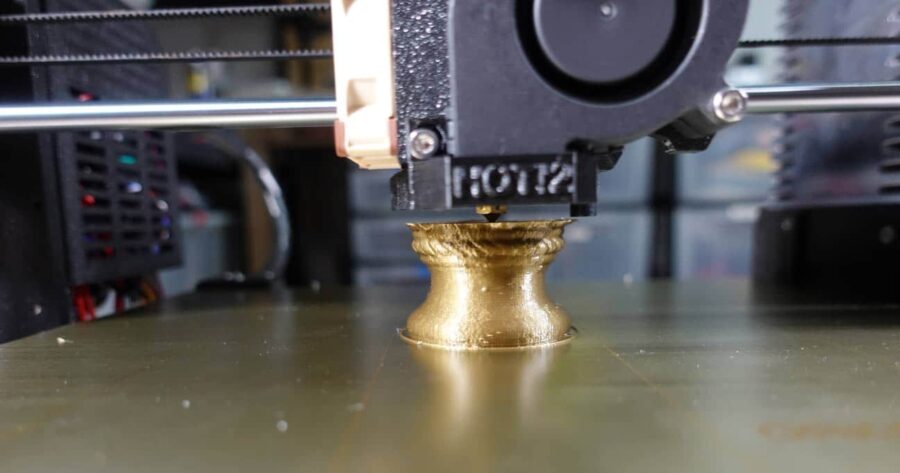
* Stand: 2024-04-21 / Bilder: Amazon API
What should I look for when buying filament?
As with all things, the saying “if you buy cheap, you buy twice” also applies to filament. However, by cheap here I don't mean the roll of filament for 15€, but rather special offers on eBay and Co. where the kilo of filament can sometimes be had for as little as 8€.
There's nothing wrong with buying some very inexpensive material on a trial basis, and if it works, you can be happy and print everything. With a renewed order, the matter can then look quite different again. Even with established manufacturers, some batches also have problems.
These are the points you should pay attention to
When buying “good” filament, first look to see if there are any empirical values on
- the manufacturer and
- the exact material.
If so, seek answers to questions such as.
- “Is the material packed airtight?”,
- “How is the coil rolled up?”,
- “Are there any known tangles during printing?”
- “How does the manufacturer or its distributor respond when problems arise?”
- “Is the production date on the material?” “How long did the filament sit before it was shipped?”
At first, some questions seem rather secondary, but if you want/will be printing for years, you will probably have some favorite manufacturers over time. From this point of view, it is good if there are few problems in the first place during printing, which can also be caused by the wrong packaging.
In addition, it is then important in case of possible problems that a manufacturer or its dealer is there for you. This is usually not the case with the bargains mentioned above. If you want to be on the safe side, take a look at the manufacturer's list:
3D Printer Filament Distributor and Manufacturer
There you will get recommendations to manufacturers/dealers whose material I have tested and was satisfied with the result or with the support. As already mentioned, these manufacturers can also sometimes produce the wrong batch. In these cases, however, they will also help out or exchange your purchase. If not, please write me about your negative experience:
Which filament is right for my 3D printer?
This is only about the technical aspects.
To find out if your desired material can be processed on your printer, you will need to answer the following questions:
Can my 3D printer only print filament from the manufacturer?
➡ This is the case, for example, with the printers from XYZPrinting. The printer recognizes by means of a chip (as with inkjet printers) which material has been inserted. Other manufacturers use filament shafts, into which only spools of a certain size fit. Here, to a certain extent, the use of other materials is structurally prevented). If you own a 3D printer kit, you can usually fall back on all manufacturers.
What filament diameter does my 3D printer need?
➡ Here there are two more precisely three sizes: 1.75 mm and 2.85 mm and 3 mm. Most 3D printers and also kits process 1.75 mm filament. However, if you have an Ultimaker, you will need the 2.85 mm size. Products with the indication “3 mm” usually have a diameter of 2.85 mm. This can cause confusion, but you can get there without hesitation.
What is the highest printing temperature of my printer?
➡ This specification is only important if you want to print material such as PEEK. Temperatures of 360°C to 450°C are required for this. Current machines can handle temperatures up to 260 °C, which allows the majority of filaments available today to be printed. However, please check if this temperature can be reached before ordering your material. To do this, simply turn up the temperature and see if it is reached.
Does my 3D printer have a heatable print bed?
➡ Unfortunately, if the answer to this question is “no”, you cannot print materials such as ABS, nylon, etc. However, you can see if a heating bed is needed for a particular filament on each product page.
If the answer is “yes” to the last question: What is the maximum temperature my heating bed will reach?➡ Especially with the kits, very high temperatures beyond 100 °C are sometimes specified here. You can't count on that, though. As with the pressure temperature, the same applies here: Turn up and see if the temperature can be reached. For materials such as ABS and ASA, high print bed temperatures are essential.
How does the production of filament work?
The filament is made from granules or pellets and dyes. These materials are first mixed together and then have to dry for a few hours before they can be further processed. If they are processed too quickly, the quality of the material suffers and so does the quality of the printed product. Drying times may differ depending on the selected material composition, but the production plays out according to the same pattern.
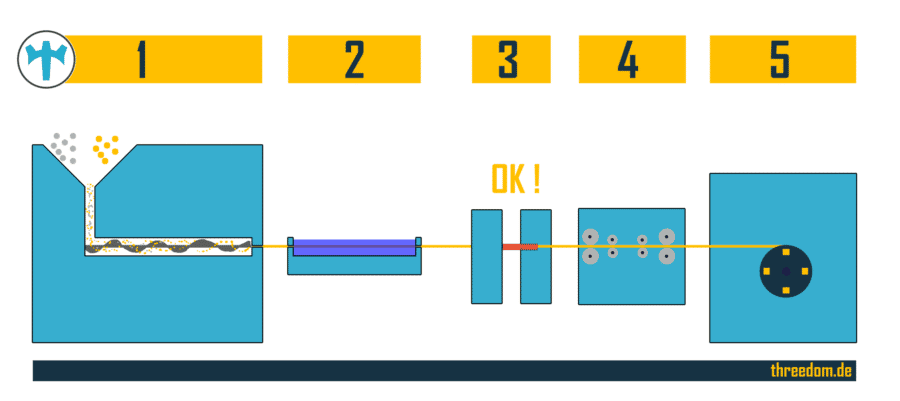
Step 1: Filling the material
First, the pellets, which have previously been mixed with the dye and dried, are filled into the centrifuge. At the end of this centrifuge is a narrow nozzle from which the material is fed out.
Step 2: Hot water bath
Now the already filamentary filament passes through a hot water bath. Among other things, this ensures that the material is brought to the correct temperature.
Step 3: Tolerance check
Here the filament runs through a tolerance check. On the manufacturer's pages or on the packaging of the material you will see specifications such as (+/- 0.05 mm). This value means that the filament may not be thicker or thinner than the diameter by more than 0.05 mm (1.75 mm / 2.85 mm).
Step 4: Tolerance correction and recheck
Here the filament is brought to the appropriate thickness. It is measured automatically and constantly controlled. In this way, deviations from the standard can be rectified immediately, because the strength of the material depends mainly on the tensile force used.
If the tolerance is exceeded or not reached in the subsequent check, production is stopped and the coil is not rolled up any further in the next step, but replaced by an empty one.
Step 5: Roll up on the spool
Finally, the filament is evenly conveyed onto the spool and then packed in an airtight package. Now it can start its way to the customer.
3D Printer Filament Frequently Asked Questions
Any questions?
If you have any questions, suggestions or constructive criticism after reading this post, please write:

